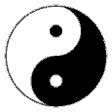to have minimal knowledge of its fundamentals and basics.
The theory of Yin and Yang was found in a Chinese Classic called Zhou Yi 《 周易 》.
易 is made up of a 日 (sun) above the character 月 (moon).
The ancients used Yin and Yang to generalize the two extremes of the same process or
quality, which may be observed in natural phenomena. The Yin-Yang symbol, or called
太极图 「Tài Jí Tú 」, with black representing Yin and white representing Yang, is a symbol
that reflects the intertwined duality of all things in nature, a common theme in Taoism.

However, nothing is absolute and independent of its opposite, nor so pure that
it does not contain its opposite in a diminished form, which is why there is
a white dot (Yang) within Yin and a black dot (Yin) within Yang.
In ancient Chinese, Yin means 'shady' or the back of the sun and Yang means 'sunny' and
refers to the front. Generally speaking, terms like darkness, internal, decline, weakness,
coldness, quietness, feminity etc. are categorised as Yin, whereas terms such as brightness,
external, mobility, warmth, activity, masculinity etc. are categorised as Yang.

Principles of Yin and Yang
To summarise the principles of Yin and Yang,
1. Interdependence - Both Yin and Yang presuppose the existence of its opposed
aspect. If any aspect separates from the other opposed aspect, it can not exist
alone. For eg. wealth and poverty, night and day, health and sickness etc.
2. Growth and decline - Both Yin and Yang are not in the state of standstill
and while they are in movement, there is a change of mutual growth and decline,
for eg. sunset is "decline of Yang and growth of Yin" and winter to spring is "decline
of Yin and growth of Yang".
3. Coordination - In normal state, Yin and Yang are usually held in balance.
As one increases, the other decreases. However, if growth and decline of
Yin and Yang are not coordinative, imbalances can occur. There are four
possible imbalances: Excess Yin, excess Yang, Yin deficiency, Yang deficiency.
4. Transformation - Under certain conditions, and at particular stages,
Yin can transform into Yang and vice versa. For eg. cold water (Yin) can
be boiled and eventually turn into steam (Yang).
5. Subdivision - Yin and Yang can be subdivided into Yin and Yang.
That is to say, there are Yin and Yang within Yin, and there are
Yin and Yang within Yang. For eg. noon at its hottest is strong Yang
or 大阳 whereas sunset which is cooler, is weak Yang or 少阳.
6. Presence in absence - Nothing is solely Yin and nothing is absolutely
Yang. Even though an opposite may not be seen to be present, since one
principle produces the other, no phenomenon is completely devoid of its
opposite state. For eg. Fire (Yang) may be bright, but the heart of the
Fire is dark (Yin), a tree (Yang) may look lustre with abundance of leaves
and flowers, but it is hollow and damp (Yin) inside.
Yin and Yang both oppose and complement each other.
It is through this opposition that each has the ability to control each other
and maintain a relative balance. Yin and Yang are EQUALLY important,
unlike the typical dualism of good and evil.


